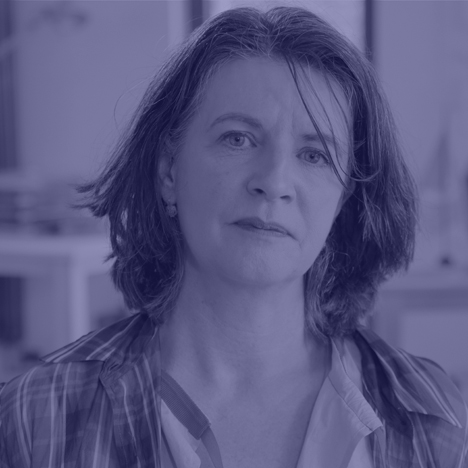
Hella Jongerius: "Why make new stuff every year? I'm happy to work on the classics"
Dezeen Book of Interviews: in the second extract from our latest book, Dutch industrial designer Hella Jongerius says there's more to design than simply creating more and more new objects.
Hella Jongerius invited us to her Berlin studio last year to discuss the projects she was working on, including her passenger plane interiors for airline KLM as well as the re-design of the North Delegates' Lounge at the United Nations headquarters in New York.
Jongerius said that designers had to be careful about who they choose to work with and stressed the importance of developing a long-term relationship with a company, rather than working for different brands each year.
"I don't believe in working for everybody," she said. "It's a waste of energy. You have to pump something up for marketing because [companies] all need a story, so you pump up something that's not relevant."

"I also believe that as you work longer [with a company], you can really trust each other and you can really build on a collection that's not only about money but is also about invention."
Jongerius also explained that she enjoyed her role at Vitra as creative director of colours, because it enabled her to use her design skills more sustainably instead of constantly trying to create completely new objects.
"Why make new stuff every year? I don't believe we have to have more stuff," she said. "I believe a designer can use her talent to update a collection and also be sustainable. Making stuff is just one design solution. Vitra has great stuff. It needs me on another level and that is what I find interesting."
Marcus Fairs: You're part of the great generation of Dutch designers that emerged in the 1990s. Why did you leave Rotterdam?
Hella Jongerius: I graduated from Design Academy Eindhoven in 1993. I lived in Rotterdam and had a studio there for 15 years. Everything was so perfect. I had a nice house, a nice studio, a nice team, good clients. I moved to Berlin five years ago because I wanted a change. I was really fed up with being a people-manager. We wanted to move as a family. I wanted to have a small studio, to find myself again in a starter's position, because I'm good there.
Marcus Fairs: Why Berlin?
Hella Jongerius: I wanted to be in Europe because, at heart, I am a European. We looked into some cities and Berlin fitted best. It's a big city but it feels like a village. It's a green city. There's not a huge design community here but I have clients all over the world, so I don't have to depend on what's going on in the city. But the main thing is that there's not a stress about money in Berlin.
Marcus Fairs: Tell us about your studio here.
Hella Jongerius: I don't have a workshop any more, but now that I work with larger companies like Vitra, there are huge teams in those companies who are doing the hands-on work. These companies have highly professional teams and specialist machines. So I make small models, but I'm spoilt because the companies can do much nicer models. Also my clients have their own research and development people working for me. I can ask them, "Can you make this model or this fabric or colour?" So it's a huge network and I'm the spider.
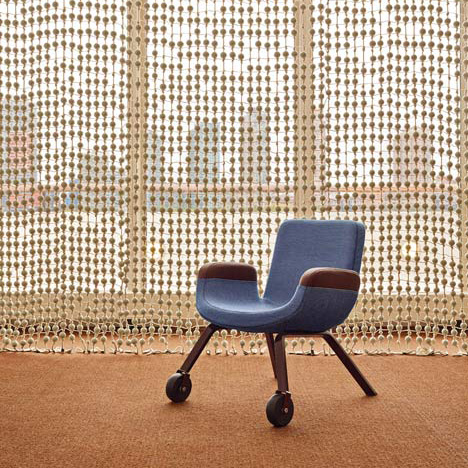
Marcus Fairs: What kinds of projects are you working on?
Hella Jongerius: I have a very small group of clients. I really am very picky who I work with because I want to have a longer relationship with clients and really build a collection for a company. So I work on textiles for Maharam in New York; I do four or five textiles a year for the US market. And then I do furniture for Vitra, but I'm also their art director for colours, textiles and surfaces. We did new colours for all the Eames plastic chairs. And now we've started on Vitra's back catalogue of Prouvé and Eames. I find it very hard to find any energy to make new stuff. Why make new stuff every year? I don't believe we have to have more stuff, so I'm happy to work on the classics. It's less waste. We just have to lift it up to a new level.
I work for the airline KLM, so I have an aviation part in my portfolio. We did the business-class cabins for the 747. We did all the soft parts but also the chairs, so it's the full interior. Now we're working on the economy cabins for the 777 and the Dreamliner planes. And I just did the interior of the UN delegates' lounge in New York with Rem Koolhaas, Irma Boom, Louise Schouwenberg and Gabriel Lester.
Marcus Fairs: You said you don't believe we need more stuff. Can you talk about that a bit more? Isn't it the job of a designer to create new things?
Hella Jongerius: On one hand, we don't need more things. But also I believe a designer can use her talent to update a collection and also be sustainable. Making stuff is just one design solution. I know I can do something new in aviation because there's not a lot going on; they need me, as a designer, to produce physical stuff. But Vitra has great stuff. It needs me on another level and that is what I find interesting.
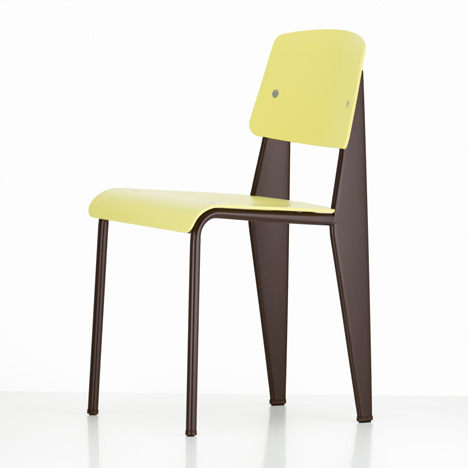
Marcus Fairs: Most other designers are quite promiscuous. They work with a brand, do a product and then move on. Do you have a problem with that approach?
Hella Jongerius: I don't believe in working for everybody. It’s a waste of energy – everything would look the same. A company has got to choose the people who can give it an identity, in the physical work, that give it a real signature, so it doesn’t have to have marketing stories.
I also believe that when a company works longer with a designer, you can really trust each other. Nowadays you can't trust one another, because you never know what the other is doing. You are in competition all the time. If this competition is gone, you can really build on a collection that's not only about money but also invention. It's another way of working and it's less about ego. It's also a sustainable way of thinking for the profession, and for capitalism and consumerism.
Marcus Fairs: You've always described yourself as an industrial designer, but a lot of your work looks very hand-crafted.
Hella Jongerius: I call myself an industrial designer because I believe the industry needs this crafty approach. At the start of my career I only did self-initiated projects and it was always a theme of mine to make individual products in an industrial way. To do individual pieces is just not interesting to me because that's just a hobby. As soon as a piece is in the machinery, in the system, as soon as you start talking about a market and money, you can reach a lot of people, you can change the system. If my ideas of individuality and creativity resonate with the consumer, then the product is more than just slick, cheap mass production.
So that's why I call myself an industrial designer. I know I am not a traditional industrial designer, sending technical drawings from my computer to a company. I have questions and I like to change the way we produce. And I can only do that if I work within the system itself.
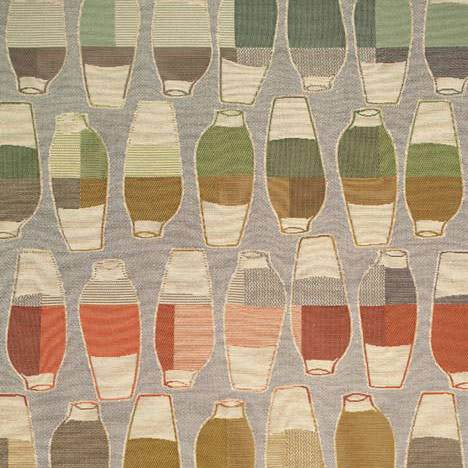
Marcus Fairs: So you're not a designer who flies in, does some sketches, then flies out again.
Hella Jongerius: No. I'm part of the whole. I have been working with companies for a long time, ten to 15 years, so I have a full picture of where we're going. Then you really can make change, you know all the layers, you can take larger steps and waste less energy. A company knows exactly what it wants, so if you have the full picture, you can really guide it and have a debate together and build a collection and a company. KLM is a corporate company in a difficult industry. It’s very demanding, very restricted and very commercial. The people speak a language that was new to me, and I spoke a language that was new to them. But after two years, we now really know where to go, where to steer and what the main problems are. We can make larger plans over ten years, things that really make sense and are not marketing tricks – a really slow revolution.
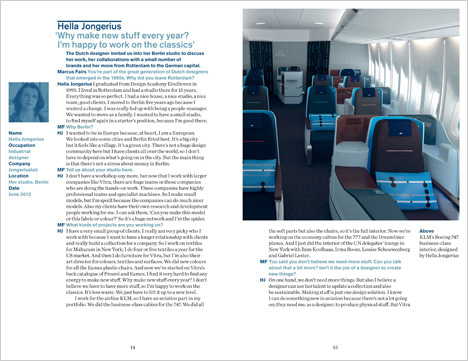
Marcus Fairs: So what can you offer a commercial company like KLM?
Hella Jongerius: At first the project was smaller. The first question was, "Can you do the carpet and the curtains and the seat covers?" So they knew me from an industrial, textile background. And then at a certain moment I said, "This chair, I can do that much better. Give me the chair." And they trusted me, so we went on. When I look back at my first PowerPoint, that was really weird. But it was for the marketing department, which means they were all young, just starting. That also helps – when there is new energy and they want to improve something. I think we were lucky. We had a chemistry together. We trusted each other. I gave them a masterclass in design, they gave me a masterclass in aviation and we did something good and we're not finished yet. We're just starting.
Marcus Fairs: Is the ambition to make the cabin look better, or to make flying more comfortable?
Hella Jongerius: The main idea is to make a more tactile surrounding, more luxury, more privacy. If you travel, you know how exhausting it is. And as soon as you are on the plane, you have extra hours because you can't telephone, you can't be on the internet, you could feel like you are on holiday, you can have a bird's perspective on life, you're off the ground. It's magical. So it is an outstanding opportunity to add something tactile, human. For business class that is easy, because there is already luxury and privacy. Now I'm doing it for economy and it's quite difficult, because the restrictions are very narrow and it's more inconvenient. But as I said, I am aware I can only take little steps.